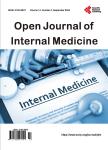Stroke (Cerebrovascular Accident): Epidemiological, Clinical and Evolving Aspects in the Internal Medicine Department of the Public Health Establishment 1 (EPS1) of Tivaouane
Stroke (Cerebrovascular Accident): Epidemiological, Clinical and Evolving Aspects in the Internal Medicine Department of the Public Health Establishment 1 (EPS1) of Tivaouane作者机构:UFR of Health Sciences Alioune Diop University of Bambey Bambey Senegal Department of Internal Medicine Regional Hospital Heinrich Lucké of Diourbel Diourbel Senegal Department of Internal Medicine Abdou Aziz Sy Dabakh Hospital Tivaouane Senegal Internal Medicine Department Regional Hospital of Thiès Thiès Senegal UFR of Health Sciences Iba Der Thiam University of Thiès Thiès Senegal
出 版 物:《Open Journal of Internal Medicine》 (内科学期刊(英文))
年 卷 期:2023年第13卷第4期
页 面:313-329页
主 题:Cerebrovascular Accident Epidemiology Risk Factors Tivaouane EPS1
摘 要:Introduction: The frequency, severity, cost of treatment, morbidity and mortality of stroke make it a real public health problem. In industrialized countries, strokes are the leading cause of physical disability in adults, the second leading cause of dementia (after Alzheimer’s disease), and the third leading cause of death (after cancer and cardiovascular disease). It’s also a major cause of depression. The objective of our study was to describe the epidemiological, clinical and evolutionary aspects of stroke in the internal medicine department of Tivaouane Hospital. Material and Method: This is a retrospective study carried out from January 1, 2015 to December 31, 2018 on the files of patients hospitalized for stroke in the medical department of the EPS1 in Tivaouane. We took into account all the patients who had a brain CT (computed tomography) scan. We collected data related to socio-demographic characteristics, history, risk factors, reasons for admission, clinical signs, paraclinical examinations, as well as evolution. Results: Out of 1999 patients, 206 files of patients with stroke were collected, i.e. a proportion of 10.3%. Our study population had a mean age of 65.53 years [16 - 97 years]. We noted a clear predominance of women (50.5%). The majority of the population came from the outskirts of Tivaouane (56.7%). Risk factors for stroke were dominated by hypertension (90.3%), dyslipidemia (19.4%), previous stroke (18.9%), and diabetes (16%). The clinical signs were dominated by a motor deficit (94.1%), speech disorders (67.4%) and consciousness disorders (47%). Ischemic strokes were predominant (65%) over hemorrhagic strokes (34.5%). The outcome was generally unfavorable with 14.6% total recovery, 58.7% recovery with sequelae and a case fatality of 26.7%. Conclusion: It emerges from this study that strokes still remain a real public health problem. Knowledge of populations of risk factors as well as their proper management is fundamental in primary preventio



